| |
|
| | As well as all the hedges we have destroyed since the 1960s the ones that are left are mainly cut so heavily that there are few berries for the birds to eat and no where safe for nesting.Modern machines leave little fallen grain and few insects survive all the poisonous spraying. The countryside during my childhood was like a Samuel Palmer painting. I feel so privileged to have seen it..... Thalia Campbell |
|
Krill | 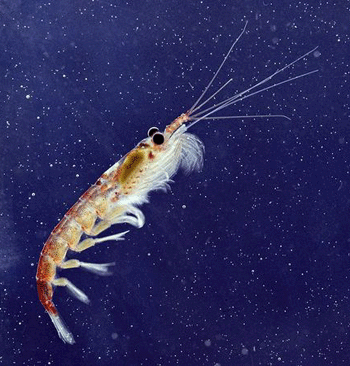 |
|
| | Why are we feeding Krill to our pets ? What about the Whales penquins and other wild life we are supposed to Love and Cherish,......The end of the world is Nigh! - Thalia Campbell
Krill has been harvested as a food source for humans and domesticated animals since at least the 19th century, and possibly earlier in Japan, where it was known as okiami. Large-scale fishing developed in the late 1960s and early 1970s, and now occurs only in Antarctic waters and in the seas around Japan. Most krill is processed to produce fish food for use in aquariums and aquacultures. The krill is sold freeze-dried.
Krill oil is marketed as a dietary supplement because it contains high amounts of Omega-3 fatty acids. It is also used to treat high cholesterol. However, even if alternatives are found and utilized for Krill oil, over half of the Krill caught are actually used for fishmeal or animal feed.
Krill are considered to be one of the most abundant and successful animal species on earth.
Unfortunately, like many other sea dwelling creatures, the number of Krill is declining
Disturbances of an ecosystem resulting in a decline in the krill population can have far-reaching effects
Most of the animals of the Antarctic – seals, whales, and squid – depend on Krill! They are also a major part of the diets of a variety of marine animals including fish, birds, and whales.
..............................................................................................................................
Recent generations have no experience of the environmental treasures we have lost so how can they conserve or bring them back. Ian Campbell
|
|
|
| |
Pastel drawing - Janice Carrera ©
We have always loved butterflies and been planting bushes which will encourage them and other endangered species into our garden |
|
Painted by Andy as a child | 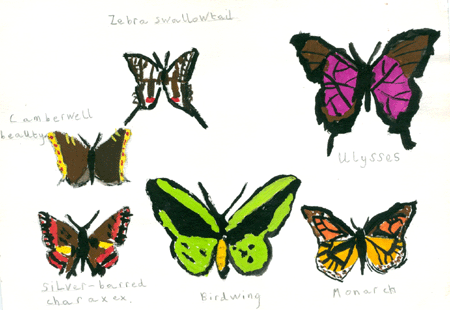 |
|
|
| | It is possible and disturbing to hold conflicting opinions.I believe in public access to the countryside but am dismayed by the destruction wreaked on the plants and wild life since my childhood in the 1940s. It is good to keep open public footpaths but to push new ones through increasingly rare pristine habitats is not good . Some board walks are so intrusive criss crossing previously safe wildlife wildernesses .I do not want to access those precious places. Public money that is given to green community projects can be very destructive ..The first lesson for young people should be we should not and do not want access to these places. The schemes are all about people not wilderness.
Thalia
I was always concerned about pesticides and chemicals in our food and cleaning products ... When hosted in canada by WILPF members including Terry Wolfwood from the peace train she shared her concerns with me and told me she uses salt, lemon juice, soda and vinegar to clean her home my fears were confirmed .Its very difficult to eat without consuming glyphosate, aspartame and other noxious products , What are we breathing in with all these household sprays? Thalia |
|
|
Red Devon cattle - see link click to view story
The Loss of our Indigenious Farm Animals
It was soon after I left Devon in the early 1960s that the red devon cattle were replaced .The milk with cream on top which was delivered daily to our door step in glass bottles and the cream we ate with strawberry jam on freshly made scones would never be quite the same. How close our local farm animals came to extinction...GM could be a similar cataclysmic event. Thalia
|
|
|
Blackbird building nest - image Mike Insall © | 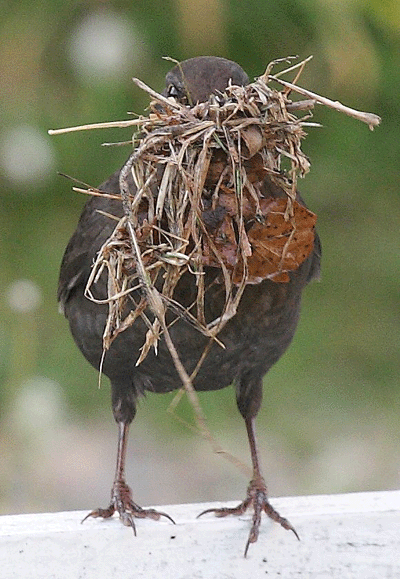 |
|
"And No birds sing" is a Keats quote from La Belle Dame san
Merci This Ribbon was from a very wealthy American household in
Milwaukee, She kept her ribbon pieces in three boxes . This piece
was from her worst box, She insisted I choose some from each box..
The ribbon project involved the richest and the poorest In USA.
Luckily I found treasure in her worst box.... The US wealthy had a
Peace organisation called Beyond War..
|
|
| |
|
| |
Totnes has been named Britain's most environmentally conscious town, now it has been identified as the place whose shops sell the greatest proportion of locally grown food in the country, 60% of produce comes from farms within 30 miles of the town
Two branches of our family live there !!
Lino print by Barbara Childs © |
|
| |
|
| |
From the Guardian | 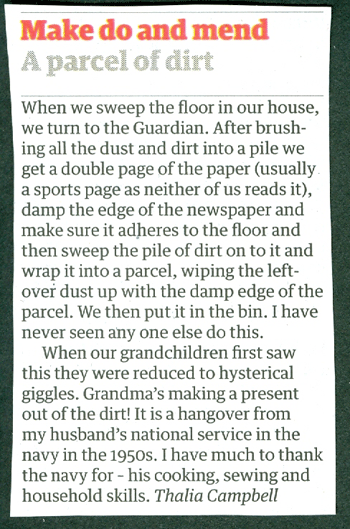 |
|
|
Ragwort | 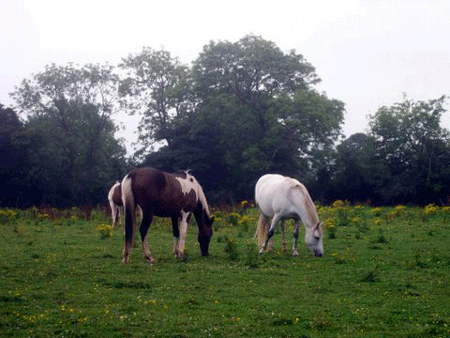 |
|
| | This morning on our way to Carew Market we saw fields of yellow
Ragwort in full flower. As a child when involved with horses with my
friend Vina we pulled up Ragwort before it flowered. It's poisonous to
animals causing long term liver damage. During my childhood it was
traditional to pull up Ragwort and to cut thistles before they
flowered. Lucy and I used to clear 30 acres of Ragwort on the SSI where
she grazed her horses in Borth.
|
|
|
Our grandparent's vegetable gardens Mansands 1930's | 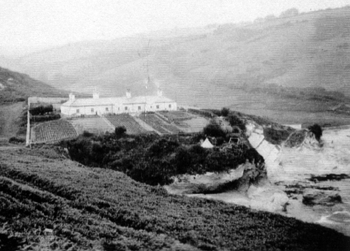 |
|
| |
Made by Thalia Campbell in hommage to Rachel Carson who in the
1960's questioned our use of Pesticides in her book Silent Spring.
The colourful embriodered tea tray towel was made by Thalia as a
child with her grandmother Gertrude Mary Bird who was a Devonshire
unsung Rachel Carson. The ric rac border is in the colours of the
American suffragists and the old style corn sheaf and flowery hedge
a pre DDT agriculture...
|
|
|
| |
| Hedgehogs could be wiped out in Britain within 15 years, several factors are contributing to their demise. Pesticides have eliminated much of their food such as caterpillars and beetles. In residential areas they face rat poisoning, strimming and lawn mowing. Their presence indicates a healthy landscape with varied habitat features. They eat slugs and snails which most gardeners treat as pests so try to eliminate them from their vegetable patch. |
|
| |
|
| |
Photo Walter Carrera ©
BIRDS ?
From Studley to Cambridge, flat as far as the eye can see
In the July sunshine ploughed fields like a black velvet sheet.
Mauve and white potatoes , barley, wheat, fat hen in the beet.
Where is space for the wildflower, food for the bird and the bee?
A picnic at the road side, bathed in sticky sweet pesticide,
choking with streaming eyes as the giant machine roars by.
No more DDT, but the poisoned fields still feed you and me.
Rachel Carson with Silent Spring led the way, she had her say
Surreal green rye grass, creeping death to the meadow and wood,
and death to the riotious flowery hedges of my childhood.
Gardens weedkilled, paved and decked, wildlife severely checked
Carnivorous pets stalk our gardens, full of well fed energy
Bird alarm calls mistaken for songs joyous and free
Nestlings die before they learn to fly
On one day we filled in the forms for the RSPB
to let them know how many birds we could see.
The RSPB founded so long ago, by those with vision to see
birds are better wild and free in bush and tree
The caged song birds in the market place, those old ways ,
On mantelpieces dusty glass domes, those dead glass eyes, those old days
Stuffed birds and handsome feathers decorating hats ,
lifted in the breeze as fashionable women strutted with men in spats
Across oceans in Australia they studied and found ,
The more dogs around the less birds and wildlife abound
especially those which live near the ground
The carnivorous smells, noise and stress, wildlife sixty percent less.
A massacre around the warm Mediterrean sea
The crack and spit of guns clean the sky
of everything that can fly
a hoopoe glimpsed in a fig tree,
the soaring honey buzzard in the hot blue sky
only minutes, at most a few hours before they die.
The children in the schools care with graffitti on the bus shelter they cry
“It's your world in which we grow and we shall grow to hate you”
The birds don't belong to you. They are our birds too.
Say younger generations and other nations.
Thalia Campbell - August 2008 ©
In hommage to Gertrude M. Goldsmith & Florence Rainford who opened my eyes. |
|
RSPB Reserve Dungeness | 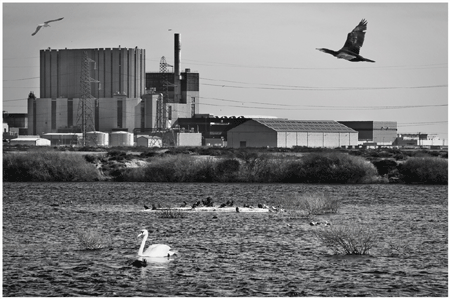 |
|
| Photo courtesy Alan Gould © |
|
|
New Sea Defences at Folkestone | 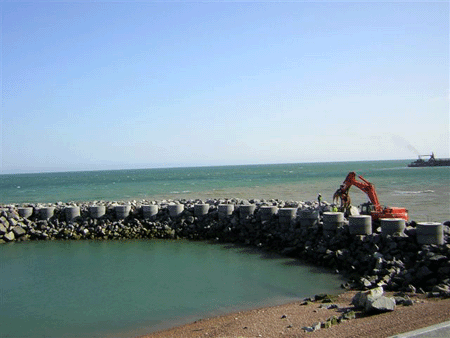 |
|
Photo Janice Carrera ©
The beaches and coastline around Folkestone were closed for a year to reinforce the sea defences.
The project cost several millions £'s and stone was brought over from the Netherlands by ship and dropped on the beach. The 7km coastal defence scheme designed to protect over 2200 homes at risk from flooding and 700 homes at risk from erosion over the next 50 years along with industrial and commercial property and irreplaceable assets such as the Leas and Royal Military canal in Folkestone.
|
|
|
Bikes | 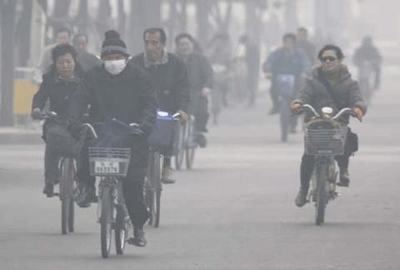 |
|
| | After the War when I was nine I was given a second hand child's Bike .
It was blue . I learnt to ride it in a few days up and down the crazy
paved garden path in the and enjoyed riding it around the local roads
and streets . Later at grammar School. I was given A Raleigh Lenton
green Bike with Drop Handle bars. It was a well made light Balanced
Bike. When riding it it felt like part of me. I explored the
countryside around Torquay going as far as Widecombe with my Sketch
book and some food. I went to Teacher Training college and after that I
sold it to my Friend Jill Bagnall who was teaching in The Potteries. I
was without a Bike bringing up children until the late 1960s when I
bought A Moulton Bike to get me to and from the Convent school where I
taught part time. Down hill in the mornings arriving fresh at School..
Took time coming home up hill..I never liked this bike with its small
wheels and trendy Design. It was the days of the Mini Skirts and very
cold iced winds in Scarborough Winters. I sold it when we left
Scarborough in 1973.
Our children learnt to ride bikes in Scarborough in the communal
fenced rose gardens in our Square. Did not think much about bikes until
I went on the Peace Train to Beijing and was lucky enough to see the sea
of bikes which parted like water for our coaches taking us from out
hotels to the UN Womens Conference ..
When I came back and saw the change in China to Cars I felt it boded
ill for our planet . We should have made the move to join them on bikes!
The move to More Bicycles and to Veganism are the two changes
individuals can and are making to fight Climate change..
What badly designed unridible trendy bikes my
grandchildren ride... And the smog/pollution in Beijing now they have
become like the west with all their cars Thalia Campbell |
|
|
Explosion Kingsnorth Power Station Kent June 2011 | 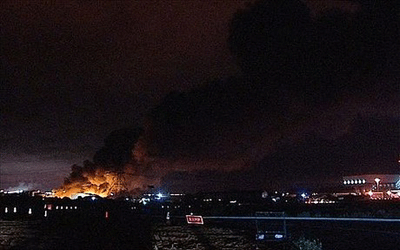 |
|
|
| |
|
| |
| |